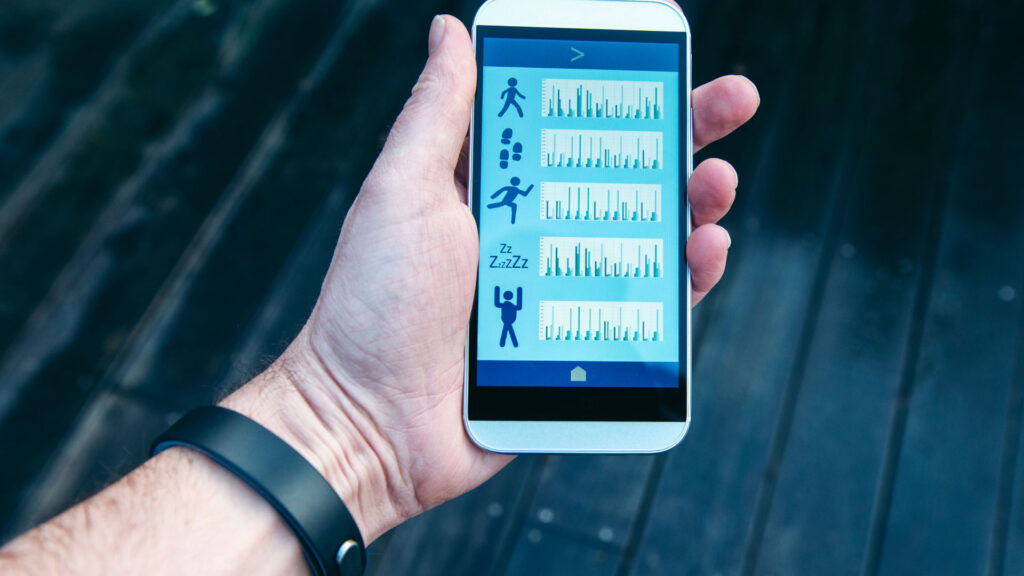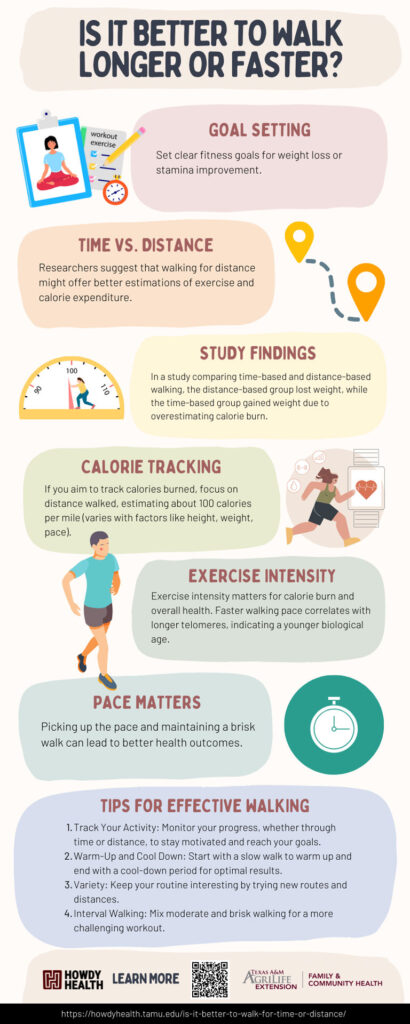Whether you’re trying to lose weight or gain stamina, it’s helpful to have a goal. One way to set your goal is to choose how long or far you will walk, but which is better? Is it better to walk faster or longer? Guidelines suggest walking 150-300 minutes (2 ½ – 5 hours) a week at a moderate intensity or 75-150 minutes (1 ¼ – 2 ½ hours) a week at a vigorous intensity.1 These guidelines are defined in terms of time and intensity, but what about distance? Does distance matter? Researchers have been looking at just that!
Go the distance
Researchers suggest that going the distance may be the better option when it comes to accurate estimations of overall accumulated exercise and energy expenditure (calories burned).
In a study of 15 overweight, but otherwise healthy subjects, participants were assigned to one of two groups:
- A time-based group who were assigned to walk or run (their choice) for an increasing time 3-5 days a week for 10 weeks; and
- A distance-based group assigned to walk or run (their choice) for an increasing number of miles 3-5 times each week, for 10 weeks.
The exercise could be done at the participant’s convenience and at their own pace. The design of the exercise program aimed to keep the total weekly calorie expenditure as close as possible between the two groups. Interestingly, the distance-based group lost an average of 8.8 pounds, while the time-based group gained an average of 2.4 pounds by the end of the 10 weeks. Why? Study authors suggest that those who walked or ran for time, rather than distance, overestimated their energy expenditure (calories burned).2
These results are consistent with other research using data from the National Runners’ and Walkers’ Health Studies (with over 15,000 participants in each). Research from these studies found that men and women who walked for time overestimated the calories they burned by 31-37%.3,4 In contrast, those self-reporting distance slightly underestimated distance walked.4
Thus, an over-estimation of calories burned can lead to eating more calories than we burn without realizing it.
Pick up the pace
While walking for distance may offer a more accurate estimate of calorie burned than walking for time, exercise intensity plays a key role in both how many calories you burn during exercise and overall health status.
In fact, researchers investigating walking pace found that a faster habitual walking pace may be causally related to longer leucocyte telomere length (LTL), an indicator of biological age, which could explain some of the beneficial effects of brisk walking on health status.5 “Telomeres are the ‘caps’ at the end of each chromosome… that protect it from damage, similar to the way the cap at the end of a shoelace stops it from unraveling.6
The study, analyzing data from over 400,000 UK Biobank participants, showed that the “more time habitually spent in higher intensity activities (e.g., brisk walking) had a stronger association with LTL than total activity.”5 The “team of researchers estimate that a lifetime of brisk walking could lead to the equivalent of 16 years younger biological age by midlife.”6 Additionally, while previous studies had “not been able to confirm whether adopting a brisk walking pace actually causes better health… this study used people’s genetic profile to show that faster walking pace is indeed likely to lead to younger biological age as measured by telomeres.”6
Timely tips
So, is it better to walk faster or longer? Walking longer distances and at a faster pace can be great for staying motivated and reaching new goals; but, do what works for you! Here are some tips to help:
1. Track your activity.
Whether you track time, distance, or some other measure, keeping track of your activity can help you see your progress and motivate you toward your fitness goals. If you’re trying to lose weight and want to track calories burned, keep track of your distance. You can approximate about 100 calories burned per mile,7 although this differs depending on your height, weight, gender, pace, terrain, and more.
2. Keep the pace.
Start walking slowly to warm up your body for the first 5 minutes. This allows nutrient-rich blood to pump oxygen to your muscles so they can perform well and reduce injury risk. After the warm-up, pick up your pace and try to maintain a brisk walk until you’re ready to cool down – the last 5 minutes.
3. Keep it interesting.
Knowing the distance of a single walking route can make tracking easy and efficient, but if you start to get tired of the same route, consider tracking the distance of multiple routes and trying new ones. String routes together to break up the boredom and gain even more distance. To figure out the distance of your walks:
- Use a GPS-driven app like MapMyWalk or Walkmeter.
- Try onthegomap.com (use the menu to select your location then select the roads you walk to map the distance)
- Drive the route and check your odometer for the distance.
4. Mix it up.
If maintaining a brisk pace seems too hard at first, or you find yourself slowing down, or just getting bored, try interval walking. Interval walking can take many forms, but one way to do it is to walk at a moderate pace for 1-2 minutes and then at a brisk pace for 1-2 minutes, alternating moderate and brisk walking as you go. You can also use landmarks for your intervals. Walk briskly to the first stop sign and then more moderately to the big tree, briskly to the next intersection, moderately past the next 10 houses, etc. Again, alternating intensity as you walk.
Getting to your goal
Adding distance and increasing your intensity can add health benefits to your walking routine. Whether you decide to track and measure your activity or not, just get out there and move! Moving some is better than moving none and adding more is even better. Tracking your walking workout by distance and picking up your pace may help you effectively move toward reaching your health and fitness goals.
Need motivation to move more and build healthy habits? Try one of our free walking programs.
Infographic
Download the PDF or share the image below to help others learn if it’s better to walk longer or faster.
- Physical activity guidelines for Americans, 2nd edition. https://healthysd.gov/physical-activity-guidelines-for-americans-2nd-edition/. of Health and Human Services. Published 2018. Accessed October 3, 2022.
- Morris CE, Garner JC, Owens SG, Valliant MW, Debusk H, Loftin M. A prospective study comparing distance-based vs. time-based exercise prescriptions of walking and running in previously sedentary overweight adults. International journal of exercise science. https://www.ncbi.nlm.nih.gov/pmc/articles/PMC5609661/. Published September 1, 2017. Accessed October 21, 2022.
- Williams PT. Distance walked and run as improved metrics over time-based energy estimation in epidemiological studies and prevention; evidence from Medication Use. PloS one. https://pubmed.ncbi.nlm.nih.gov/22916114/. Accessed October 12, 2022.
- Williams PT. Advantage of distance- versus time-based estimates of walking in predicting adiposity. Medicine and science in sports and exercise. https://www.ncbi.nlm.nih.gov/pmc/articles/PMC3780575/. Published September 2012. Accessed October 14, 2022.
- Dempsey, P.C., Musicha, C., Rowlands, A.V. et al.Investigation of a UK biobank cohort reveals causal associations of self-reported walking pace with telomere length. Communications Biology. https://doi.org/10.1038/s42003-022-03323-x. Published April 20, 2022. Accessed October 12, 2022.
- Stop the clocks: Brisk walking may slow biological ageing process, study shows. News | University of Leicester. https://le.ac.uk/news/2022/april/walking-speed-ageing. Published April 20, 2022. Accessed October 21, 2022.
- Parr, B. Health and fitness: Is it really 100 calories per mile. AP News. https://apnews.com/article/51de4cba6ffe48b0886cf9b2c7a6ba8a. Published June 4, 2012. Accessed October 21, 2022.






